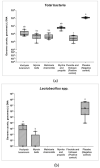The Effect of Toothpastes Containing Natural Extracts on Bacterial Species of a Microcosm Biofilm and on Enamel Caries Development
- PMID: 35326877
- PMCID: PMC8944744
- DOI: 10.3390/antibiotics11030414
The Effect of Toothpastes Containing Natural Extracts on Bacterial Species of a Microcosm Biofilm and on Enamel Caries Development
Abstract
This study investigated the effects of herbal toothpaste on bacterial counts and enamel demineralization. Thirty-six bovine enamel samples were exposed to a microcosm biofilm using human saliva and McBain saliva (0.2% sucrose) for 5 days at 37 °C and first incubated anaerobically, then aerobically-capnophilically. The following experimental toothpaste slurries (2 × 2 min/day) were applied: (1) Vochysia tucanorum (10 mg/g); (2) Myrcia bella (5 mg/g); (3) Matricaria chamomilla (80 mg/g); (4) Myrrha and propolis toothpaste (commercial); (5) fluoride (F) and triclosan (1450 ppm F), 0.3% triclosan and sorbitol (Colgate®, positive control); (6) placebo (negative control). The pH of the medium was measured, bacteria were analyzed using quantitative polymerase chain reaction, and enamel demineralization was quantified using transverse microradiography. The total bacterial count was reduced by toothpaste containing Myrcia bella, Matricaria chamomilla, fluoride, and triclosan (commercial) compared to the placebo. As far as assessable, Myrcia bella, Matricaria chamomilla, and Myrrha and propolis (commercial) inhibited the outgrowth of S. mutans, while Lactobacillus spp. were reduced/eliminated by all toothpastes except Vochysia tucanorum. Mineral loss and lesion depth were significantly reduced by all toothpastes (total: 1423.6 ± 115.2 vol% × μm; 57.3 ± 9.8 μm) compared to the placebo (2420.0 ± 626.0 vol% × μm; 108.9 ± 21.17 μm). Herbal toothpastes were able to reduce enamel demineralization.
Keywords: antimicrobial strategies; dental caries; oral biofilms; plants.
Conflict of interest statement
The authors declare no conflict of interest. The funders had no role in the design of the study; in the collection, analyses, or interpretation of data; in the writing of the manuscript, or in the decision to publish the results.
Figures





Similar articles
-
The Effect of Solutions Containing Extracts of Vochysia tucanorum Mart., Myrcia bellaCambess., Matricaria chamomilla L. and Malva sylvestris L. on Cariogenic Bacterial Species and Enamel Caries Development.Caries Res. 2021;55(3):193-204. doi: 10.1159/000515234. Epub 2021 May 17. Caries Res. 2021. PMID: 34000728
-
Antibiofilm and anti-caries effects of an experimental mouth rinse containing Matricaria chamomilla L. extract under microcosm biofilm on enamel.J Dent. 2020 Aug;99:103415. doi: 10.1016/j.jdent.2020.103415. Epub 2020 Jun 24. J Dent. 2020. PMID: 32592827
-
Effect of commercial herbal toothpastes and mouth rinses on the prevention of enamel demineralization using a microcosm biofilm model.Biofouling. 2019 Aug;35(7):796-804. doi: 10.1080/08927014.2019.1662897. Epub 2019 Sep 13. Biofouling. 2019. PMID: 31514534
-
Effect of experimental toothpaste containing hydroxyapatite nanoparticles and propolis, with and without fluoride, on the microcosm biofilm and enamel demineralization.Biofouling. 2023 Mar;39(3):339-348. doi: 10.1080/08927014.2023.2217689. Epub 2023 Jun 1. Biofouling. 2023. PMID: 37259560
-
Effect of TiF4/NaF and chitosan solutions on the development of enamel caries under a microcosm biofilm model.J Dent. 2021 Aug;111:103732. doi: 10.1016/j.jdent.2021.103732. Epub 2021 Jun 24. J Dent. 2021. PMID: 34174348
Cited by
-
Natural products from traditional medicine as promising agents targeting at different stages of oral biofilm development.Front Microbiol. 2022 Aug 12;13:955459. doi: 10.3389/fmicb.2022.955459. eCollection 2022. Front Microbiol. 2022. PMID: 36033896 Free PMC article. Review.
-
Antibacterial Effect of Miswak herbal toothpaste Compared to Fluoride Toothpaste in High Caries Risk Patients: Randomized Clinical Trial.J Clin Exp Dent. 2023 Jul 1;15(7):e526-e534. doi: 10.4317/jced.60332. eCollection 2023 Jul. J Clin Exp Dent. 2023. PMID: 37519323 Free PMC article.
-
In Vitro Study on Green Propolis as a Potential Ingredient of Oral Health Care Products.Antibiotics (Basel). 2022 Dec 6;11(12):1764. doi: 10.3390/antibiotics11121764. Antibiotics (Basel). 2022. PMID: 36551420 Free PMC article.
-
Antimicrobial and Antibiofilm Properties of Hydroxyapatite/Nano-Hydroxyapatite in Preventing Dental Caries: A Systematic Review.Eur J Dent. 2025 Jul;19(3):563-579. doi: 10.1055/s-0045-1802568. Epub 2025 May 1. Eur J Dent. 2025. PMID: 40311636 Free PMC article.
References
Grants and funding
LinkOut - more resources
Full Text Sources
Research Materials
Miscellaneous

